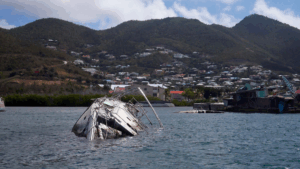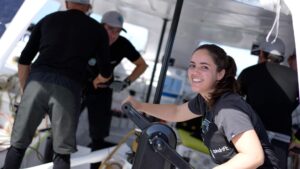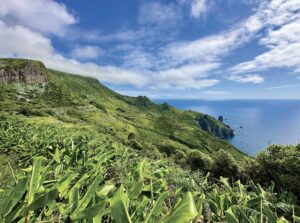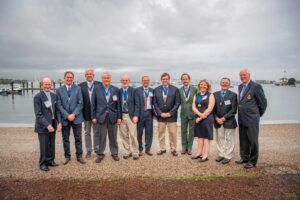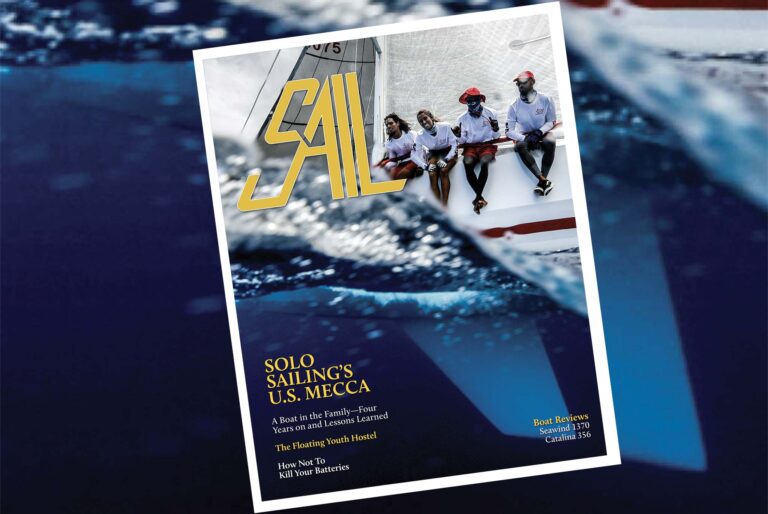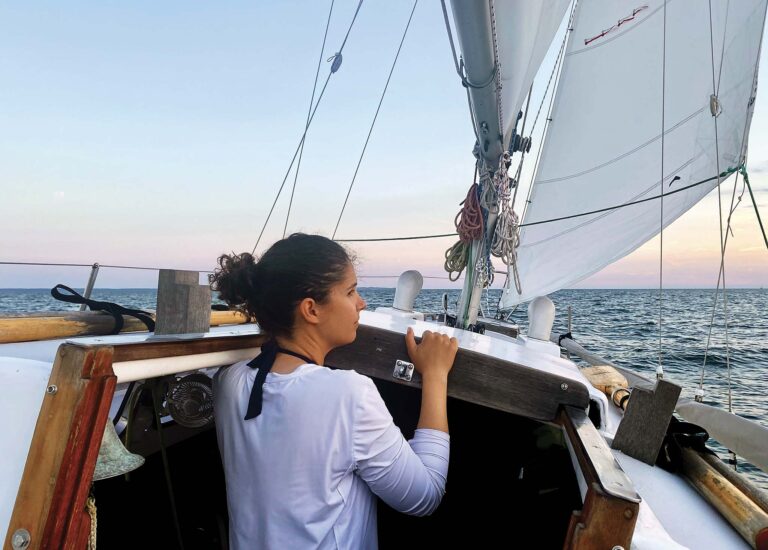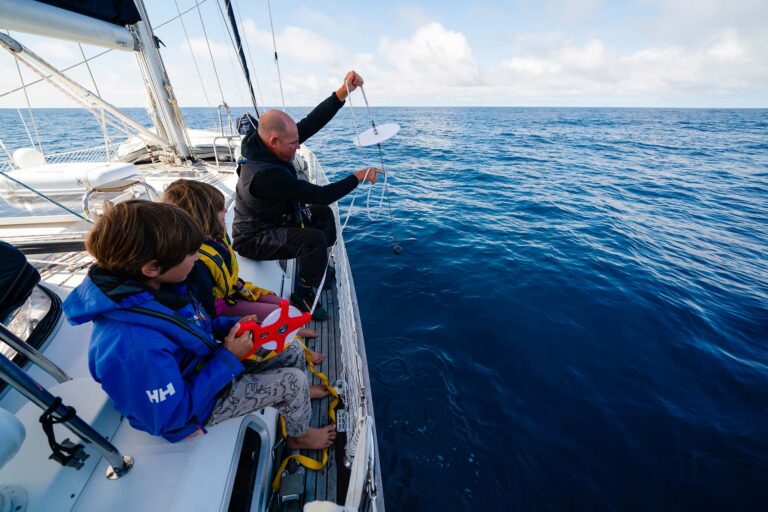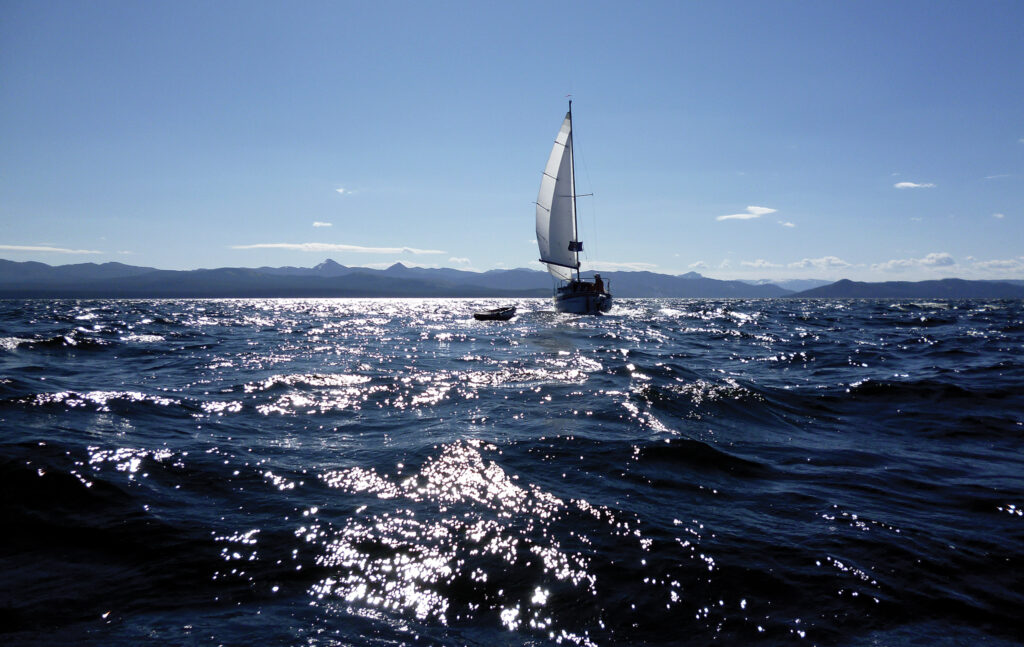 Photo courtesy of Geoff Baumann
Photo courtesy of Geoff BaumannHigh in the Rocky Mountains of Wyoming lies Yellowstone Lake, an inland sea surrounded by evergreen forests. Frozen most of the year, the water temperature rarely reaches 60°F, even with the dozens of hot springs flowing into its depths.
At 7,733 feet above sea level, the weather changes quickly. Chilly summer mornings ease into warm, wispy afternoons that can erupt into sail-dousing dashes. Squalls boom down like swirls from the jet stream with lightning, blinding rain, and crashing waves. Being windbound all day isn’t unusual. Evenings generally calm down with brilliant sunsets and starry nights. There may be 100,000 people in Yellowstone National Park, but on the lake there is little sign of them, and nature is in charge.
This story begins in 1954 with my dad and his brothers stranded on Dot Island in a June snowstorm. When they staggered home three days late, my mother said, “I was so glad to see him I could have killed him.” It became family lore, so naturally I was drawn there.
For 20-some summers, my wife, Mary, and I have sailed the lake on my Spirit 23, Sweetwater. In August, I keep a berth at Bridge Bay Marina, a modern facility with friendly services and ice tumbling into glasses at five o’ clock. On occasion that’s nice, but I’m really here for solitude and adventure on this wild lake.
We have our favorite spots. On Dot Island I once found a rusty beer can. Another misty morning, we saw the Loch Ness monster, but it turned out to be two otters bounding through the water together.
For this trip, my friend Jan and I drove up over Sylvan Pass and into the Yellowstone Caldera, which holds the lake. At the ranger station we were issued our back country permit and given a weather report: variable winds.
 Photo courtesy of Geoff Baumann
Photo courtesy of Geoff BaumannBridge Bay has an impediment to sailboats—the bridge. Masts must be lowered to clear it. Jan’s a handy guy with the gin pole, though, so we were soon through, remasted, and under sail on a scenic reach toward the Lake Hotel. A series of puffs tested us as we rounded Gull Point into bigger water. The area is notorious for sudden and sustained afternoon blows, and the waves were already up. We pulled on wet weather gear and confidently began the crossing. In the lee of Dot Island, we paused to reef the main and check the rigging before setting out again into the blow.
Jan has his own boat, so we drove Sweetwater harder than I normally would. Passing Frank Island we admired the Promontory, a headland between the East and Southeast arms. We were tired and the wind had eased, so we decided to take a shore break. We’ve done this before. I prepared a stern anchor as Jan went forward to douse sail and ready a long shore line. Then we went in.
The trick is to drop the anchor with enough rode to hold as we approach the shore. I dropped, we touched, and he jumped, looping us to a driftwood log. I tightened back on the anchor line, and we were good. It’s a nice little beach, partially protected by rocks on either side. We shed life jackets, stretched, and sat in the sun with our lunch. But no sooner were we settled than the wind veered and rose, driving whitecaps into the transom.
“Damn!” I hurried back aboard and went for the motor. It fired obediently, and Jan came on with the bow line as we bucked in the surf. He pulled in the stern anchor while I held down the little outboard and gunned it in reverse. He dashed forward to secure the flapping jib. I worked the motor and tiller trying to gain enough way to come about. As we came broadside, Jan slid off the deck and disappeared.
We’ve all practiced man overboard drills with water jugs and boat hooks. This was not that. I wasn’t sure where he was, and my hands were full keeping us off the rocks. Fortunately a hand came up to the gunwale, and I pushed it onto a cleat. He was clinging to a jib sheet and slapping alongside.
 Photo courtesy of Geoff Baumann
Photo courtesy of Geoff Baumann“Hold on and keep your feet away from the prop!” I yelled. Facing the waves now, I motored out far enough to try pulling him in. No chance of that. He was getting cold and tired. Going back and forth between the motor and tiller, I headed to the lazarette to get to the swim ladder. Out it came. I hung it over the side, and we heaved him aboard. He took a few breaths then went forward again to lash the thrashing sails, then crept below. I steered for Frank Island and its sheltering bay.
The old Johnson 7.5-horse has never let me down, except for that one year I didn’t check the spark plugs. On this day, it was the hero, doggedly driving us into the waves, whining when the stern rose, then right back to work. Clouds came down, obliterating any sunset. In the dark we gained the lee of the island. Frank Island was not on our permit, but I thought the Park Service would be understanding on an occasion like this. No matter, there were no boats anywhere. I idled in toward the forest, dropping the anchor in 10 feet of water, gunned “Johnny” once more to set it, and shut him down with a friendly pat.
The wind blew fiercely through the trees, but we were safe. Wet and cold but greatly relieved, I crawled in and closed the hatch. Jan had the propane stove throbbing. We enjoyed hot toddies and wise conversations with big bowls of Captain Spasms Clam Chowder. Recalling the event like frames of a movie, we were humbled and lucky, and we knew it. He was as shocked to suddenly be in the water as I was to see him gone. Rolling at anchor, we settled into our bunks as the wind rushed overhead and away into the darkness.
What We Did Wrong
We were overconfident in thinking the wind was done with us. We should not have been so quick to tie up in a questionable anchorage and boldly go ashore.
As we got back aboard, we didn’t take the extra seconds to put our life jackets back on.
Even though I was intent on maneuvering away from the rocks, I should have anticipated the boat’s motion as we came broadside and warned Jan.
What We Did Right
We checked in at the ranger station to get our permit and obtain a weather report, though the wind turned out to be more severe than predicted.
Though anxious to get underway, we checked the rigging while lowering and raising the mast and talked early about reefing procedures.
We kept our heads throughout the incident. Though under stress, we both recognized and acted on what to do so we came away with a good story instead of a tragedy.
Man overboard drills are most valuable when done in rough conditions, but even simple ones give a sense of what is needed and where to look for safety equipment.
November/December 2024

